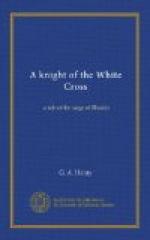Sir Thomas Tresham, as soon as he heard of the landing of Edward, had hastened up to London. In his uncertainty how matters would go, he brought his wife and son up with him, and left them in lodgings, while he marched north with Warwick. As soon as the defection of Clarence opened the road to London, he left the Earl, promising to return in a few days, and rode to town, arriving there two days before Edward’s entry, and, purchasing another horse, took his wife and son down to St. Albans, where leaving them, he rejoined Warwick. In a few days the latter had gathered sufficient forces to enable him to risk the fortunes of a battle, and, marching south, he encamped with his army on the common north of Barnet. Edward had come out to meet him, and the two armies slept on Easter Eve within two miles of each other.
Late in the evening Clarence sent a messenger to the Earl, offering to mediate, but the offer was indignantly refused by Warwick.
In the darkness, neither party was aware of the other’s precise position. Warwick was much stronger than the king in artillery, and had placed it on his right wing. The king, in his ignorance of the enemy’s position, had placed his troops considerably more to the right than those of Warwick’s army. The latter, believing that Edward’s line was facing his, kept up a heavy cannonade all night upon where he supposed Edward’s left to be — a cannonade which was thus entirely futile.
In the morning (April 14th) a heavy mist covered the country and prevented either force from seeing the other’s dispositions. Warwick took the command of his left wing, having with him the Duke of Exeter. Somerset was in command of his centre, and Montague and Oxford of his right.
Edward placed himself in the centre of his array, the Duke of Gloucester commanded on his right, and Lord Hastings on his left.
Desirous, from his inferiority in artillery, to fight out the battle hand to hand, Edward, at six o’clock in the morning, ordered his trumpets to blow, and, after firing a few shots, advanced through the mist to attack the enemy. His misconception as to Warwick’s position, which had saved his troops from the effects of the cannonade during the night, was now disadvantageous to him, for the Earl’s right so greatly outflanked his left that when they came into contact Hastings found himself nearly surrounded by a vastly superior force. His wing fought valiantly, but was at length broken by Oxford’s superior numbers, and driven out of the field. The mist prevented the rest of the armies from knowing what had happened on the king’s left. Edward himself led the charge on Warwick’s centre, and having his best troops under his command, pressed forward with such force and vehemence that he pierced Somerset’s lines and threw them into confusion.




